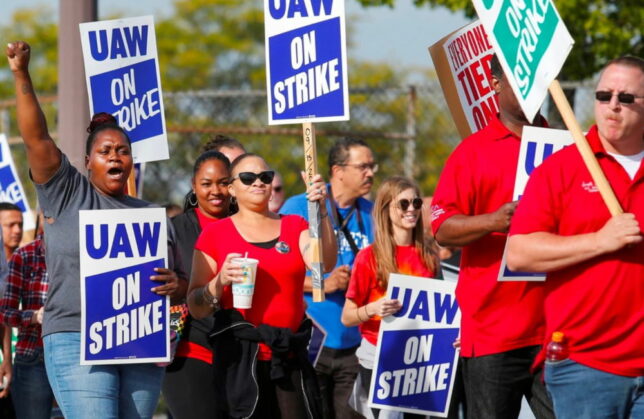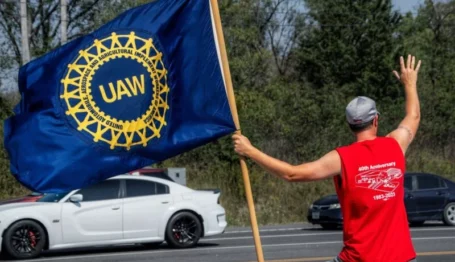Labor Watch
What You Need to Know About the UAW Strike
 Credit: United Auto Workers.
Credit: United Auto Workers.

Last night, the United Auto Workers (UAW) called strikes at production facilities of the Detroit Three automakers Ford, General Motors, and Stellantis (formerly Chrysler). I’ve compiled a primer for Capital Research Center readers.
Is This Strike Important?
Much of the press coverage—in right– and left-leaning outlets—has framed the strike as “historic,” focusing on the fact that this is the first time the UAW has called a simultaneous strike against the three major Detroit automakers. This is a change in strategy for the union, which usually follows a tactic known as “pattern bargaining,” wherein the union negotiates a model contract with one of the Three, striking against that firm if necessary. That agreement then becomes the model for the agreements with the remaining two automakers.
Whether the strike will actually be historic—think Walter Reuther’s “sit down strike” that won UAW bargaining power in the 1930s or his unsuccessful strike to take control of car prices that contributed to the 1946 strike wave that led to significant reforms to unions’ powers—remains to be seen. However, given that the union’s action will take thousands off the job, slow or stop car production and distribution, and cause economic consequences to uninvolved parties, it is very important.
What Does the Union Want?
This answer is simple: more money for less work. The union has demanded a 46 percent nominal raise (in some places reported as 36 percent) plus cost-of-living adjustments, the restoration of the defined-benefit pension instead of a 401(k)-style contribution system, and 40 hours’ pay for a 32-hour workweek. As Steve Delie of the Mackinac Center notes, automakers surviving while meeting these demands is “only possible with a mid-20th-century economic boom,” which is obviously not what the current economy looks like.
What Are the Automakers Offering?
The automakers are offering less but still substantial advances to workers. Ford and GM are offering 20 percent wage increases (Stellantis offered 17.5 percent), with $20/hour starting pay and cost-of-living adjustments if inflation exceeds a certain threshold.
What Has This Got to Do with Electric Cars?
Thanks to the general metropolitan-progressive war on cars, government subsidies for electric vehicles, the Biden administration’s anti-energy agenda, and regulations from states like California that target combustion engines for elimination, the Detroit Three have increasingly focused on electric vehicles. This changeover has led the companies to commit to a combined $120 billion infrastructure investment related to electric cars—cars on which at present, they are losing scads of money.
The automakers argue that conceding to the union’s demands amid this electric vehicle changeover expense could send them under. Job losses that the union hopes to avoid are also likely from the shift from combustion to charging. The right-of-center America First Policy Institute estimated that adopting the Biden administration’s directives to increase the proportion of electric vehicles on the roads from 6 percent to 67 percent would eliminate 117,000 jobs in the industry.
Eureka! We Can Split Organized Labor from Big Green Now, Right?
In response to the declared strike, populist Republican politicians including the U.S. Senators enamored of the anti-capitalist project of American Compass have praised the strikers and demanded the administration and the automakers drop their electric car push.
But if one is hoping to break through the haze of social justice unionism and drag the UAW to the political center, one ought to not hold one’s breath. The alliance between Big Labor and Big Green is wide and deep, and the Democrats with whom they ally have every incentive to rip off the public to ensure both are paid off with other people’s—our—money. While the UAW has balked at some of the administration’s more aggressive moves, the union expressed a desire to work with the administration for “standards that are good for workers and the environment,” showing a clear willingness to cut a deal with its friends.
Recall during the initial debate over the Inflation Reduction Act that the tax incentive for electric car purchases was explicitly written to apply to only union-made cars. At the risk of speculating, the UAW, Big Green, and probably the automakers themselves would be perfectly happy to include a similar bailout provision in some future legislation to keep the UAW’s numbers up and cover the carmakers’ losses.
So What Now?
As of writing, some 13,000 UAW workers are striking. The union has threatened to expand the strike if an agreement is not reached. Observers have argued that the sides are likely too far apart for a quick resolution. The UAW has a reported $825 million strike fund, which would support a full walkout against all three carmakers for about three months.
A continued or expanded strike would significantly harm neutral businesses and consumers. The consultancy Anderson Economic Group estimates that a 10-day full strike could cost the U.S. economy $5.6 billion.
If the UAW’s play expands, American consumers may start to feel the sort of pain that their grandfathers and grandmothers felt in the strike-mad winter of 1945–46 and may be reminded why their grandparents responded by curtailing union power.



